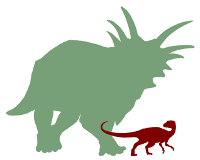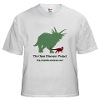 Anyone who has dealt with puppies, kittens, or human babies has probably noticed their freakish (“cute”) body proportions relative to adults. The heads are too big and the limbs too small! Fortunately, most of us grow out of this condition as we mature. The change (or lack of) in the proportions of an organism as its overall size changes is called scaling.
Anyone who has dealt with puppies, kittens, or human babies has probably noticed their freakish (“cute”) body proportions relative to adults. The heads are too big and the limbs too small! Fortunately, most of us grow out of this condition as we mature. The change (or lack of) in the proportions of an organism as its overall size changes is called scaling.
Scaling relationships can be compared between species, within species, or even within the same individual over the course of its development. In the present round of the ODP, we’ll be focusing on the first comparison, although many of the examples that follow will draw on within-species or within-individual scaling.
Scaling, as a whole, can be divided into two general forms: isometry and allometry. The key difference between these terms is how the different parts of an organism change in proportion to each other with increasing or decreasing overall size. Isometry (a.k.a., isometric scaling) means that everything stays the same. Here, imagine a condition in which a baby maintains its proportionately large head size into adulthood. Contrast this with the actual condition, allometry. In humans (and most other vertebrates), the head becomes proportionately smaller to the rest of the body. When different parts of the body scale at different rates, this is called an allometric scaling relationship. You can see this in the puppy and adult golden retrievers at right.
Allometry is divided into two classes – negative and positive. Our oft-cited baby’s head is a classic example of negative allometry—the head becomes relatively smaller with increasing body size. Other features might show positive allometry—for instance, the horns of male bighorn sheep grow at a much faster rate than the rest of the body. In a lamb, the horns are tiny compared to the skull. In the adult, the horns are huge!
Scaling comparisons are pretty straight-forward for linear measurements (e.g., comparing scaling of femur length relative to humerus length). Isometry is indicated by a one-for-one change in size between the two elements. But, the complications of mathematics mean that things are a little less intuitive when considering areas or volumes. Consider a cube measuring 1 mm along each side. Its volume (length x width x height) is 1 cubic mm. If we double the size to 2 mm along each side, its volume doesn’t just double, but leaps to 8 cubic mm (2 mm x 2 mm x 2 mm). Bumping the size up to 3 mm along each side, the volume is now 27 cubic mm (3 mm x 3 mm x 3 mm). Length along any given dimension has changed by a factor of 3, but volume has changed by a factor of 27 (3 cubed). Similarly, the cross-sectional area has changed by a factor of 8 (2 cubed). We won’t be doing much with areas or volumes for the present study, but this is an important attribute of scaling to keep in mind.
So, one important analysis to be considered in ODP 1.0 is how limb bone lengths scale against each other. For instance, does the humerus increase its length at the same rate as the ulna, or metacarpals, or phalanges? Or, does the humerus get relatively shorter in larger animals? The departure from simple isometry might be for any number of reasons – perhaps larger animals need relatively more surface area for muscle attachment. Or perhaps weight limitations mean that certain bones can’t increase their size too quickly. We’ll just have to analyze the data and see what the trends are!
Image credits: Puppy image licensed under Creative Commons License 2.0; adult golden retriever in the public domain.
Key Concepts: Scaling Anyone who has dealt with puppies, kittens, or human babies has probably noticed their freakish (“cute”) body proportions relative to adults. The heads are too big and the limbs too small! Fortunately, most of us grow out of this condition as we mature. The change (or lack of) in the proportions of an organism as its overall size changes is called scaling. Scaling relationships can be compared between species, within species, or even within the same individual over the course of its development. In the present round of the ODP, we'll be focusing on the first comparison, although many of the examples that follow will draw on within-species or within-individual scaling. Scaling, as a whole, can be divided into two general forms: isometry and allometry. The key difference between these terms is how the different parts of an organism change in proportion to each other with increasing or decreasing overall size. Isometry (a.k.a., isometric scaling) means that everything stays the same. Here, imagine a condition in which a baby maintains its proportionately large head size into adulthood. Contrast this with the actual condition, allometry. In humans (and most other vertebrates), the head becomes proportionately smaller to the rest of the body. This is called an allometric scaling relationship. Allometry is divided into two classes – negative and positive. Our oft-cited baby's head is a classic example of negative allometry—the head becomes relatively smaller with increasing body size. Other features might show positive allometry—for instance, the horns of male bighorn sheep grow at a much faster rate than the rest of the body. In a lamb, the horns are tiny compared to the skull. In the adult, the horns are huge! Scaling comparisons are pretty straight-forward for linear measurements (e.g., comparing scaling of femur length relative to humerus length). Isometry is indicated by a one-for-one change in size between the two elements. But, the complications of mathematics mean that things are a little less intuitive when considering areas or volumes. Consider a cube measuring 1 mm along each side. Its volume (length x width x height) is 1 cubic mm. If we double the size to 2 mm along each side, its volume doesn't just double, but is cubed (2 mm x 2 mm x 2 mm) to 8 cubic mm. Bumping the size up to 3 mm along each side, the volume is now 27 cubic mm (3 mm x 3 mm x 3 mm). Length along any given dimension has changed by a factor of 3, but volume has changed by a factor of 27 (3 cubed). Similarly, the cross-sectional area has changed by a factor of 8 (2 cubed). We won't be doing much with areas or volumes for the present study, but this is an important attribute of scaling to keep in mind. So, one important analysis to be considered in ODP 1.0 is how limb bone lengths scale against each other. For instance, does the humerus increase its length at the same rate as the ulna, or metacarpals, or phalanges? Or, does the humerus get relatively shorter in larger animals? The departure from simple isometry might be for any number of reasons – perhaps larger animals need relatively more surface area for muscle attachment. Or perhaps weight limitations mean that certain bones can't increase their size too quickly. We'll just have to analyze the data and see what the trends are!



It seems to me that we have still not decided whether to explicitly incoporate the phenomenon of evolutionary change in ODP 1.0 (or as discussed in earlier threads, just compare between the monophyletic AND paraphyletic [basal …] groups as that).
In the first scenerio our focus would be (actually) heterogeny and we would aim to net out novel evolutionary changes e.g. the “telemetacarpalian” condition I suggested on cursorality, while in the latter, we wound limit ourselves to plain allometry as discussed by Andy here.
Are we to decide on this later on? Thanks!
If by utilizing methods such as PICs or patristic distances or OLS, yes, we will explicitly be looking at evolutionary change (if I understand your question correctly). And, you can get at issues of allometry with these methods (PICs and OLS, in particular), while still accounting for phylogeny. . .
The example plots so far have been the monophyletic/paraphyletic group comparisons because it’s quick and easy (and somewhat meaningful).
And yes, the methods are also open to discussion, depending on what questions we find that might be interesting to address!
But the more interesting meta-answer to Leo’s question is that, whatever way we use the data in the initial paper, that data will continue to be publicly accessible to anyone who wants it — so you can run whatever analyses might occurs to you, and hopefully discover new insights that haven’t even occurred to Andy, Matt and me. All we ask is that you hold back on submitting any such analysis until our initial paper is published — see the FAQ for details.
Ah, thanks for the information! Sorry that I’ve not made my query clear. I was saying the we might have some methodological problem comparing e.g. hadrosaurids with basal iguanodontids with “hypsilophodontids” (which are species along the same line of evolution) the same way as we do with “hadrosaurids v.s. neoceratopsians v.s. thyreophorans”. Of course, this may turn out to be a non-issue (red face!).
Your thoughts are absolutely correct (no need for the red face).
Pingback: Mid-December Update « The Open Dinosaur Project
Pingback: Things to Do « The Open Dinosaur Project